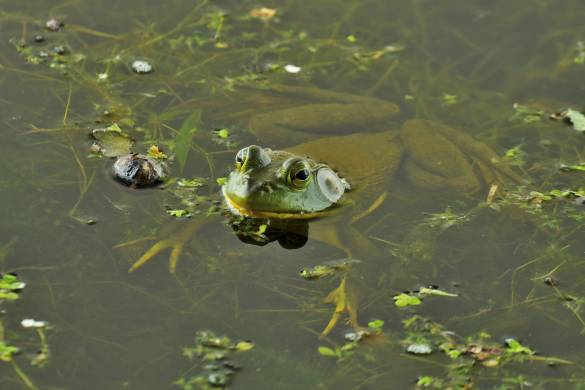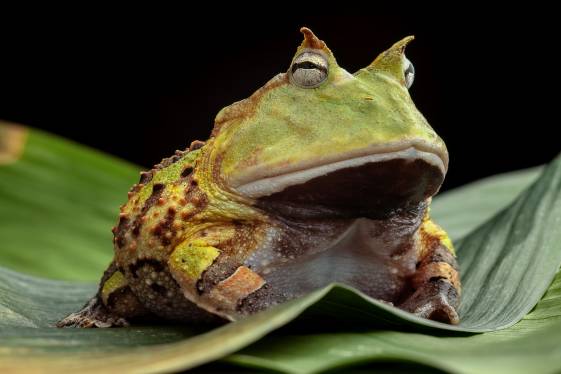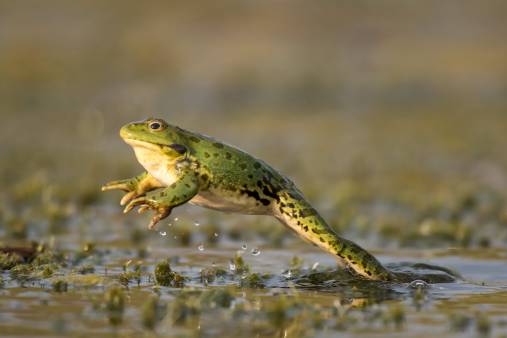Connect with a verified veterinarian in minutes. Licensed vets are available 24/7 to answer your questions. No need to worry about your furry family member.
On a warm summer’s night, you may hear a sound that’s quite distinctive. To some, it sounds like “ribbit,” while to others, the sound is a bit different. These sounds appear most often near water, such as ditches, ponds, or even near the marshy edges of a lake. The sounds you’re hearing are produced by frogs!
Have you ever wondered how frogs make their croaking sounds? If so, then you’re in the right place. We’ll take a look at how frogs produce their sounds (and hear them), as well as how frogs use croaking to communicate, and more!
How Do Frogs Communicate with Each Other?
The reason frogs croak is to communicate with other frogs. It’s usually the male frogs you can hear croaking. They’re working hard to attract a female frog in hopes of mating. If a female frog likes the song, then the frogs will pair and mate.
But you may be wondering why frogs croak mainly at night. That’s a good question. The answer is that this is the safest time of the day for males to let female frogs know where they are and that they’re available. At night, it’s more challenging for a frog’s predators to find him.
Frogs also croak and make sounds during the day. When they’re calling during the daytime, male frogs are letting other male frogs know this is their territory and to keep out.
Frog Hearing
Did you know that frogs do have an eardrum and an inner ear, much like us? Frogs’ ears are different, however. You’ll never see a frog with long ears hanging down or standing at attention over his head. At least, we’ve never heard of a frog like that!
The frog’s eardrums are located directly inside his head. They work to protect the inner ear, something like a shield. The eardrums are covered with skin, which doesn’t have any glands. The eardrum is usually placed behind the frog’s eyes. The eardrums are known as tympanums.
The tympanums work very much like our own ears. There’s a bone attached to the tympanum; when sound hits the eardrum, the vibrations then travel down the bone to the inner ear. Here, there are semicircular canals, cochlea, and papilla. The frog’s tympanum works both above and underwater, meaning the frog can hear in or out of the water.
Because the distance between a frog’s tympanum is very short, they aren’t able to hear high frequencies. They can hear lower frequency sounds very well, however. This is why a frog’s croak is deep and loud. It’s easier for other frogs to hear!

Review symptoms, medications & behavior to keep your pets healthy with a Vet Online in just minutes.
Ask a Vet Live NowHow Do Frogs Make Their Croaking Sound?
As amazing as it is to know how a frog hears, you’ll also be amazed to learn how frogs make their croaking noises!
Frogs create their croaking sounds with their vocal cords, which are similar to ours. First, the frog must breathe in and closes his nostrils. The air he inhaled is forced backward and forward between the lungs and the vocal sac.
Air from the lungs is then forced across the vocal cords, which causes the vocal cords to vibrate. The air continues through the frog’s windpipe back to the vocal sac. Next, the sound is amplified by an air sac (called a vocal sac), which is found at the bottom of their mouth. The sound is controlled by the frog’s glottis, which controls the flow of air and the creation of a frog’s croak.
The vocal sac has the ability to stretch out like a balloon, which helps the frog make the sound louder and stronger. The sound produced by a frog can travel up to a mile away!
Is It True Frogs Croak Before a Storm?
Can frogs predict the rain? It may be that’s what’s going on when you hear more croaking frogs before a storm. Scientists aren’t exactly sure, but it seems that frogs may croak before a storm in order to attract a mate.
The storm means more water will be available to lay eggs, which is perfect for frogspawn. So, the males may be letting females know it’s time to get together and start a family before it rains!
After it rains, male frogs will also croak more in hopes of attracting a mate. Again, it’s because there’s more water around, which means more places to lay eggs.
What’s more, male frogs may also croak after it rains because there’s more food around. Rain and wind can knock insects to the ground, stir earthworms out of the dirt, and more. All of these are on the frog’s diet. After eating well, frogs may be ready to mate. So, it could be a kind of dinner bell and/or an alert it’s time to start a family!
Do All Frogs Make the Same Sound?
The short answer is no; not all frogs make exactly the same sounds. Sounds are determined by the frog species. Every species has a different sound that fits their specific habitat.
Some frogs make a high-pitched whirring sound, while others make a “bonk” sound. What’s more, the female of each species is only attuned to the sound produced by male frogs of the same species. So, there’s no confusion about which female frogs the males are trying to attract.
Do Female Frogs Croak?
No, female frogs do not croak like the males. However, they do make some chirpy sounds.
Fun Facts About Frogs
To end this article, we’d like to include some fun facts you may not know about frogs!
1). There are over 6,000 species of frogs found around the world.
2). Frogs are uniquely structured animals. They have a short backbone attached to a large head. They have very wide mouths and powerful legs for jumping and hopping.
3). Frogs and toads are in the same family! They are in the order Anura.
4). Frogs are amphibians, which many people know. Frogs are able to live in the water and on land. In fact, the word “amphibian” comes from two Greek words. “Amphi” means “both,” and “bios” means “life.”
5). The largest frog is the Goliath frog, which is found in West Central Africa. This frog can grow up to 1 ft long. The smallest frog is the Cuban pygmy frog, which is only about half an inch long! The largest frog found in the US is the bullfrog, which can grow to be more than six inches long.
So, there you have it! Frogs use some amazing methods to create their croaks and to hear the world around them! Frogs are incredible animals, that’s for sure!
Connect with a verified veterinarian in minutes. Licensed vets are available 24/7 to answer your questions. No need to worry about your furry family member.

Tom
Tom has always loved to write since he was little - he wanted to be either a writer or a veterinary doctor, but he ended up being a professional writer while most of his works are based on animals. He was born in San Francisco but later moved to Texas to continue his job as a writer. He graduated from the University of San Francisco where he studied biotechnology. He is happily married and a soon to be father!
Review symptoms, medications & behavior to keep your pets healthy with a Vet Online in just minutes.
Ask a Vet Live Now




